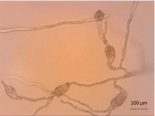
Special Article - Plant Pathology
Austin J Plant Biol. 2021; 7(1): 1025.
First Report of Globisporangium ultimum Causing Constriction on Hypocotyl of Beta vulgaris in North Dakota, USA
Haque ME1 and Parvin MS2,3*
¹University of North Dakota, USA
²Bangladesh Agricultural Research Institute, Bangladesh
³Gottfried Wilhelm Leibniz Universität Hannover, Germany
*Corresponding author: Parvin MS, Bangladesh Agricultural Research Institute, Bangladesh
Received: January 06, 2021; Accepted: January 20, 2021; Published: January 27, 2021
Keywords
Oomycetes, Hypocotyl, Sugar beet
Editorial
Sugar beet (Beta vulgaris) sowing to post-harvest is continuously encountered with wide range of soil-borne pathogens including Rhizoctonia, Fusarium, Aphanomyces, Rhizopus, Pythium, Talaromyces, Clonostachys, and Geotrichum. These evident to cause substantial qualitative and quantitative losses. In May/2019, dark brown to black irregular water-soaked lesions were observed near the soil-line (constriction of hypocotyl) on sugar beet seedlings in Prosper (46.9630° N, 97.0198° W), North Dakota (Figure 1). Approximately 2-5% of disease incidence was recorded. Small pieces (10 mm²) of symptomatic root tissues were cut from the margins between infected and healthy tissue, and disinfected with 10% sodium hypochlorite for 1 min, rinsed three times with autoclaved water, and then placed on Corn Meal Agar (CMA) amended with pimaricin-vancomycin- Pentachloronitrobenzene (PCNB) [1] for incubation at 20°C in the dark for 5 days. Subsequently, single hyphal tips were transferred to Water Ager (WA) (Figure 2). In total, 8 isolates were developed from diseased beets. Isolates were developed light fungal biomass on WA in 14 days. Microscopically, hyphal swelling and globular or lemon shaped sporangia were present (Figure 3). Based on macroscopic and microscopic characteristics, the fungus was speculated to be Oomycetes genus [2]. Determining the species, genomic DNAs of 8-isolates were used for Polymerase Chain Reaction (PCR) using ITS- 6 and ITS-7 primer. PCR amplicons were cleaned with E.Z.N.A ®Cycle Pure Kit, OMEGA, and 8 samples were sent for Sanger sequencing to GenScript (Piscataway, NJ) [3]. The sequences were identical, and standard nucleotide blast search showed 99% sequence identity to Globisporangium ultimum (Genbank accessions: MK794771.1). The nucleotide sequence was deposited in Genbank (MN086365.1). Phyto-pathogenicity testing was performed with 2-week old sugar beet susceptible cultivar which was inoculated with a 2-week old WA culture (5 mm² mycelial cut). This plug/mycelial cut was placed at a 1/2-inch depth close to seedlings in each plastic pot (27 x 13 x 13 cm, T.O. Plastics, Inc.; Clearwater, MN, USA) which was filled with vermiculite and perlite mixer (PRO-MIX FLX) amended with osmocote (N-P-K:15-9-12) fertilizer (Scotts Company; Marysville, OH). The pots were arranged in completely randomized design. The study was done twice with four replicates and 10 plants per replicate. One week of post-inoculation, 40% of the inoculated plants developed similar damping-off symptoms as discussed above (Figure 4), whereas mock-inoculated plants were healthy. Pathogen re-isolated from the infected hypocotyl tissue and was further confirmed morphologically and molecularly, fulfilled Koch’s postulates. Globisporangium species complex were previously reported to cause damping-off on aleppo pine (Pinus halepensis Mill) in Australia, Africa, Mediterranean, rootcrown rot of pepper (Capsicum annuum) in Turkey and alfalfa [4- 7]. To our best knowledge, this is the first report of Globisporangium ultimum causing constriction on hypocotyl of sugar beet seedlings in North Dakota, USA.

Figure 1: Infected sugar beet seedlings with constriction on hypocotyl collected from field.

Figure 2: Globisporangium ultimum grown on water agar.

Figure 3: Morphological characteristics of G. ultimum.

Figure 4: Inoculated artificially with G. ultimum.
References
- Conway KE. Selective Medium For Isolation Of Pythium Spp From Soil. Plant Disease. 1985; 69: 393-395.
- Uzuhashi S, Tojo M, Kakishima M. Phylogeny of the genus Pythium and description of new genera. Mycoscience. 2010; 51: 337-365.
- Haque ME, Parvin MS. First report of Pythium ultimum causing damping-off of Sugar beet (Beta vulgaris. L) in Montana, USA. Plant disease. 2020.
- Berg LE, Miller SS, Dornbusch MR, Samac DA. Seed Rot and Dampingoff of Alfalfa in Minnesota Caused by Pythium and Fusarium Species. Plant Disease. 2017; 101: 1860-1867.
- Lazreg F, Belabid L, Sanchez J, Gallego E, Garrido-Cardenas JA, Elhaitoum A. First Report of Globisporangium ultimum Causing Pythium Damping- Off on Aleppo Pine in Algeria, Africa, and the Mediterranean Region. Plant Disease. 2013; 97: 1111-1111.
- Dervis S, Özer G, Türkölmez S, Çiftçi O. First report of Globisporangium heterothallicum causing root and crown rot of pepper in Turkey. New Disease Reports. 2020; 41: 36.
- Haque ME, Parvin MS. First Report of Fusarium equiseti Causing Leaf Yellowing and Stunting on Sugar Beet (Beta vulgaris L.) in Montana, USA. J Plant Physiol Pathol. 2020; 8: 4.